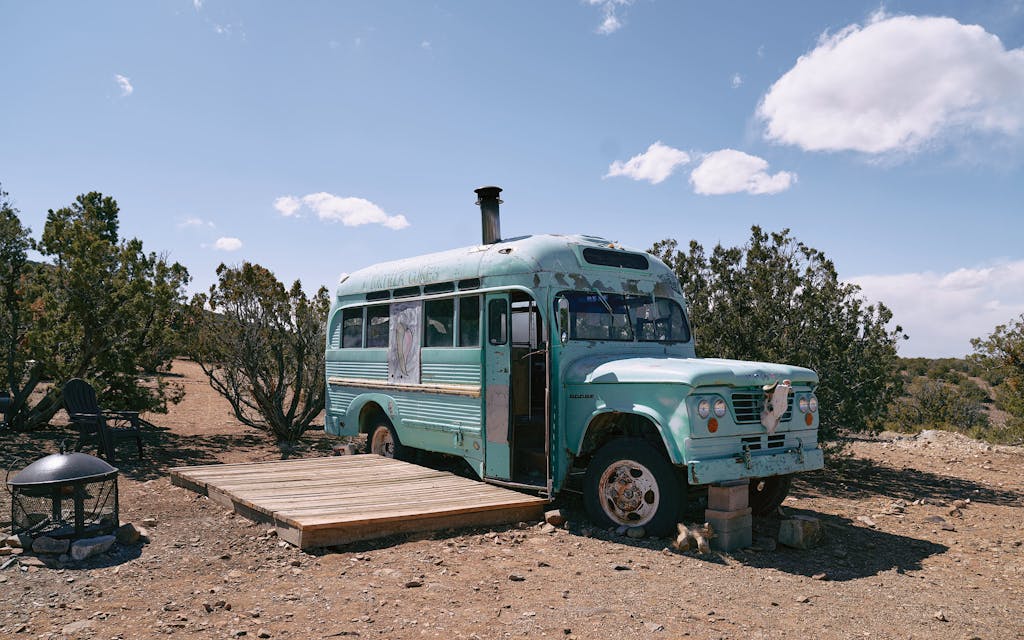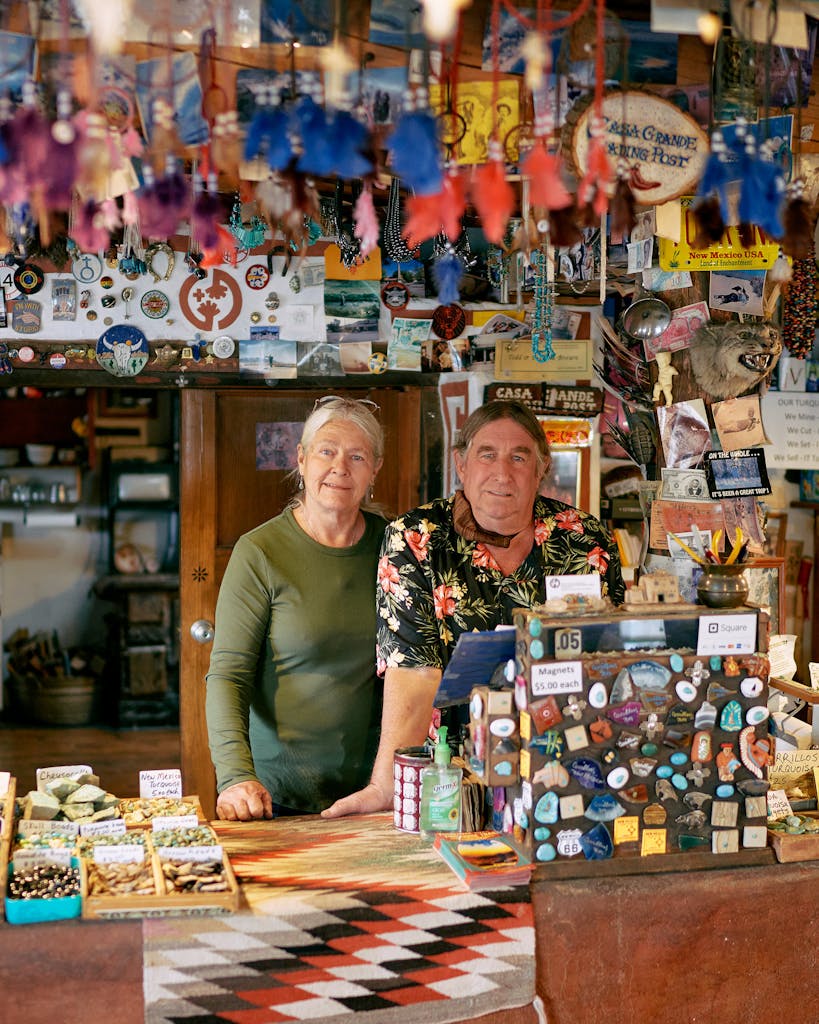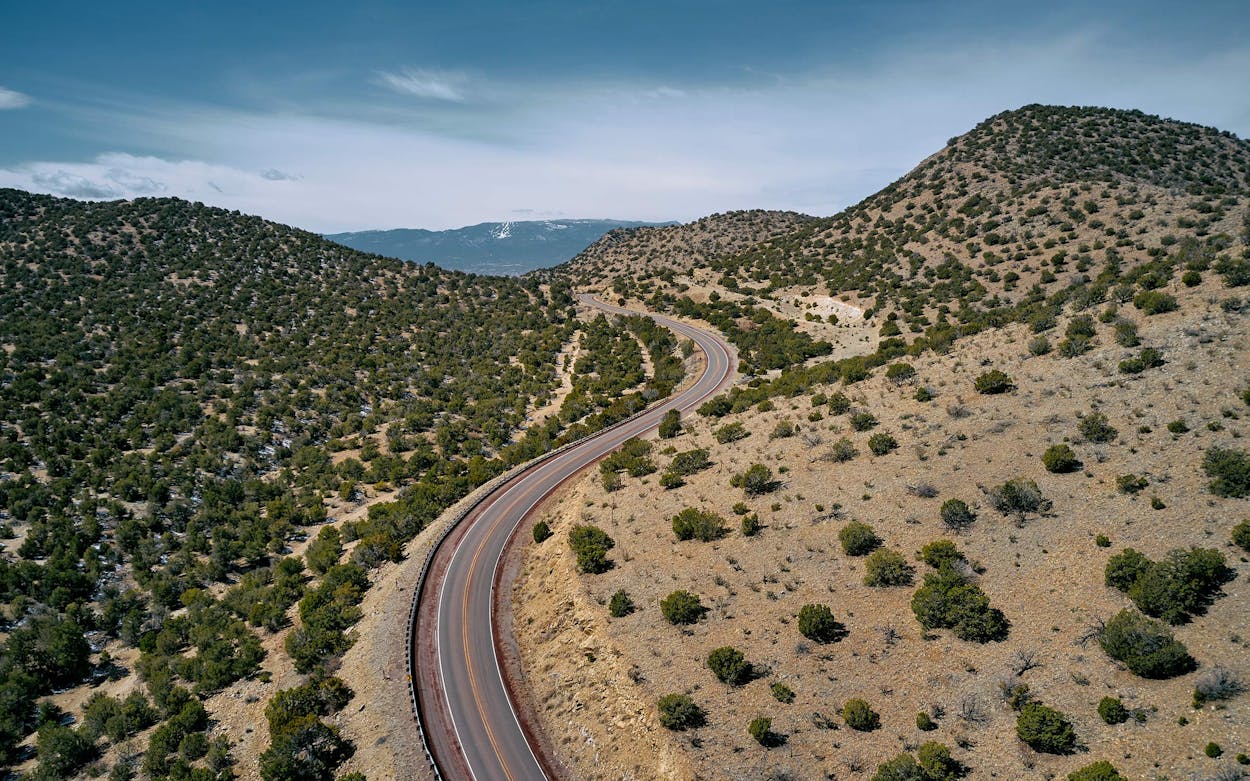Before my first trip to New Mexico, for a writing conference when I was 24, I mistakenly imagined the Southwest to be one large desert. After flying from Houston to Albuquerque and embarking on the two-hour-plus drive to Taos, I couldn’t really comprehend the scene unfolding before me as I left one pueblo and entered another, the spaces between gloriously free of Targets and PetSmarts and Best Buys. The pink mountains rolled into silvery ones covered in pine trees, with mesas and gorges scattered between. I stayed outside Taos in the village of Arroyo Seco, where I spent too much money on a silver ring that held a piece of turquoise in its prongs—and not very securely, as I’d find out.
On the drive back to the airport, I decided to take the Turquoise Trail National Scenic Byway, a roughly fifty-mile stretch of New Mexico State Road 14 connecting Santa Fe to Albuquerque. And then, somewhere along that trail, I lost my own turquoise. As my left hand dangled out of the open window, the stone fell out of its setting. It was my only souvenir from the trip, and I was heartbroken. Three years later, on one of the first dates I went on with my future husband, I told him about my fondness for New Mexico, and when he said, “I’d go there with you,” I knew I would marry him.
Over the next decade, we road-tripped to New Mexico many times, first as a couple and then with our two sons. We always headed toward points north—the Pecos National Historical Park, next to Santa Fe, and the Carson National Forest, cradling Taos, were favorite destinations. A few years ago, we bought a house in Chamisal, a small village in Taos County, and eventually decided to move there. We hadn’t planned to relocate a week before what would be the first major pandemic shutdown, but it was under those circumstances that we began a new life.

The pandemic restrictions inspired a lot of in-state exploring. At first, we stuck to places close to home, hiking and camping around the Santa Barbara Campground, and then going farther north to the always chilly and totally sublime Rio Costilla Park and Campground. We kayaked in a mountain lake and stayed warm and dry in our tent during an early summer rain. This was the New Mexico I knew and had fallen in love with, the wooded forests of pine and aspen, of rushing streams, wildflowers, and butterflies.
But late last summer, the writer in me was craving a change of scenery and creative inspiration. I booked a stay at the Shanti Community, an off-the-grid glamping spot where travelers stay in yurts, refurbished school buses, and tricked-out Volkswagen vans. The Shanti is just southwest of the old mining town of Madrid, a stop along the Turquoise Trail—probably not far from where I lost my ring’s stone years ago—that was revived by artists and hippies in the seventies. I reserved a yurt for the beginning of August as an overnight for me and my nine-year-old son, nearly canceling when the forecast showed temps in the nineties. To preemptively cool down, Elias and I stopped at the Jezebel Gallery and Soda Fountain, on Madrid’s main street, and ate cookie dough ice cream out of paper cups. Of this sweet stretch of road, lined with coffee shops, art studios, and restaurants such as the Mine Shaft Tavern, my son, who’d been feeling nostalgic about our life in Texas, said, “It reminds me of South Congress!” And it did, I had to agree, reflect the funky, light spirit of the Austin street loved by tourists and residents alike. We drove farther south along the Trail, the Ortiz Mountains to our east, turning slightly west onto a road rough enough that I was glad to be in our four-wheel-drive Subaru. Slowly we drove into the foothills, the occasional driveway surprising and impressing me with the deliberateness with which one would choose to carve out space here.
Once I exit, it is clear the trip has changed, that the road sometimes becomes more of a means to an end than a part of the journey itself.
I’ve long had an obsessive fascination with yurts. These round structures, which usually consist of a wooden frame covered in felt, originated with the nomads of central Asia. I imagine the more authentic of these might become stuffy, but our Shanti yurt—built on a platform, its walls made of heavy canvas rather than animal hides—was surprisingly cool when we arrived. With high ceilings, a rounded roof, and a skylight, it felt spacious and was furnished with a woodstove, a queen-size bed, a bistro table and chairs, and a small kitchen area complete with propane burner and butcher-block counter. Large screens kept out flies but let in steady cross-breezes. Before the sun set, we took off on a walk, hiking in the golden light, the air cooling around us as my son climbed along the rock walls lining the arroyo. That night, we listened to coyotes howl while we played hands and hands of Uno. After Elias fell asleep, I slipped out to the yurt’s small deck and sat under a sheet of stars, some of them falling.
I’ve returned to the Shanti Community many times since that initial trip. Once, my older son, Xavier, and I stayed in one of the VW buses. At 6,800 feet, the desert spills before you in one direction; the mountains ascend in another. To me, there is something magnetic and ethereal about this expanse of the world, the surreal and alien landscape, the way the wild domed mountains of pink-and-beige igneous rock, dotted with sagebrush and piñon and juniper, appear far off until, as the ribbon of Highway 14 continues to unfurl, you realize you’ve somehow become a part of the picture.
Even with all the trips to Madrid, it had been years since I’d driven the entire Turquoise Trail. So, in March, I decide to start from the south and work my way up. My family will join me at the beginning, but then I will indulge in a little bit of highway solitude, just as I did on my first road trip all those years ago.
We take two vehicles to Placitas, a little village just north of the scenic byway’s southernmost point, where we stay in a sprawling Airbnb, one of several cabins surrounding an expansive deck with a firepit, barbecue grill, and pool. It claims to have been used as a location for a scene in Breaking Bad, though it’s far enough from Albuquerque to not be part of the kitschy tourism that has sprouted in the wake of the show’s popularity. (See Walt and Skyler’s home! Check out the A1A Car Wash! Behold Los Pollos Hermanos, which is really a place named Twisters!) It is the beginning of our spring break, and the change of seasons is evidenced by the traces of snow visible only at the highest peaks of the surrounding Sandia Mountains. At night, we watch the palette of the sky pale and give way to deepening shades of blue.
Pit Stop!
After a day at White Sands National Park, only one sandwich will do: the double-patty Tiger Burger from the nearly forty-year-old Hi-D-Ho Drive In, in Alamogordo. Order it topped with the state’s famous green chiles. —José R. Ralat
In the morning, I wake before the others and drive to the Placitas trailhead, joining a solitary car in the lot off the main road. Several trails scatter in all directions, and even though I’ve never been here, I can tell there are no wrong choices. It is the time of day when the moon is still visible, although the sun is rising, immense and absolute, from behind the hills that I walk toward but will not reach. After my hike, I join my family for breakfast at the Placitas Café, and my husband shows me how to get to the Turquoise Trail by driving through the village and heading south through the
Cibola National Forest and National Grasslands. I take our truck and leave my boys and husband behind, cuing up a playlist on my phone, fingers tapping the steering wheel along to the beginning of the Grateful Dead’s “Brown-Eyed Women.” This is a kind of liberation: traveling alone on a forest road, listening to music turned up loud, remembering trips that have come before, ones to see best friends and lovers and family, uncovering answers you may or may not be looking for.
A few miles into my drive, I begin to encounter some rough road. For nearly half an hour, I navigate the truck over rocks and around ruts, hugging the road’s edge as other cars pass, listening to branches scrape against the passenger window, roof, door panel. I am nearing this road’s end, with less than three miles to meet up with the Trail, when a sign warns about driving at one’s own risk, as the road is technically closed for winter. The ruts and rocks have become a muddy, slick path that gives way and slips underneath my tires. It is humbling and amusing to perform a multiple-point turn to reverse course, retrace the bumps, and meander back toward the highway—which is, inevitably, wide open.
I head south onto Interstate 25, exiting near Albuquerque to travel east on I-40, which, if you kept driving, would bring you through Santa Rosa, Tucumcari, and, eventually, Amarillo. I finally turn off onto the beginning of the Turquoise Trail, singing along with Brandi Carlile’s sulky version of “Take Me Home, Country Roads.” Tijeras, considered the Trail’s gateway, is a village of a few hundred, a place first inhabited by Ancestral Puebloans, the forebears of the modern Pueblo tribes and the first to mine the blue-green stone for which the Trail is named. I head north, passing makeshift roadside stands selling jerky, chiles, piñones, and potatoes. I stop at Cabra Coffee, in Cedar Crest, nestled in a cluster of shops including a furniture store, a brewery, and a medical cannabis dispensary. Farther north, I drive through Golden, the site of the first gold rush west of the Mississippi, even before those in Colorado and California. It was officially designated a ghost town in the late 1920s, and as I watch it flash by, I wonder how the ghosts—the Native Americans, the Spanish, the miners of many backgrounds—reconcile with one another.


Because it’s a Saturday, Madrid is bustling. I drive past the main plaza, where previously I purchased some art for my son’s room, an abstract butterfly. Today the town’s narrow main street is full of masked tourists, and with my window down, I hear music wafting from the Mine Shaft Tavern, some Americana cover band playing to please. I’ve stopped for breakfast burritos and coffee at Java Junction before, but it’s getting late, so I park and head into the shop at the front of the Jezebel Gallery and Soda Fountain. Predictably, there are dream catchers and bundles of sage; coffee mugs, coasters, and T-shirts are adorned with the Zia symbol. I know I’ll find what I’m looking for: a turquoise ring with an adjustable band. I choose one with a large oval stone that lies between the two knuckles of my pointer finger. It is inexpensive, and the stone is probably not real turquoise. Still, I like the way it feels and am happy to have it, a replacement souvenir but from a place that now seems more and more like a home.
Between Madrid and Santa Fe lies nearly half the Trail. Every mile north, I’m closer to being off the road, returned home and to domestic life. I pass the turnoff for the straw-bale house where I once stayed with the boys and where I sent my husband for a night away to read and write and think (and figure out whether we should build a straw-bale house).

The final village along the Trail is Cerrillos, another old mining town, now home to a petting zoo and a sweet Airbnb with a rock-wall shower and hot tub, within walking distance of hiking and biking trails at Cerrillos Hills State Park. The landscape changes once you’re on the north side of Cerrillos, the hills receding, the Sandia and Ortiz Mountains farther and farther in the rearview. The dusty beige desert stretches out until new mountains appear—the Sangre de Cristo range—which you could follow all the way to Colorado. Just before the Santa Fe city limits, I pass through San Marcos, a once-vibrant farming community now dotted with adobe homes and studios. It is the northernmost stop on the Trail, and once I exit, it is clear the trip has changed, that the road sometimes becomes more of a means to an end than a part of the journey itself.
Long before moving to New Mexico, I felt I understood the meaning behind the state’s tourism campaign “New Mexico True.” Sure, there are good reasons for tourists, especially Texans, to flock here for world-class skiing in Taos or gallery-hopping in Santa Fe. But the greatest gift this place has to offer is to become a part of the landscape.
Stephanie Noll is a writer and teacher in Chamisal, New Mexico.
This article originally appeared in the May 2021 issue of Texas Monthly with the headline “Uncovering Hidden Gems on the Turquoise Trail.” Subscribe today.







